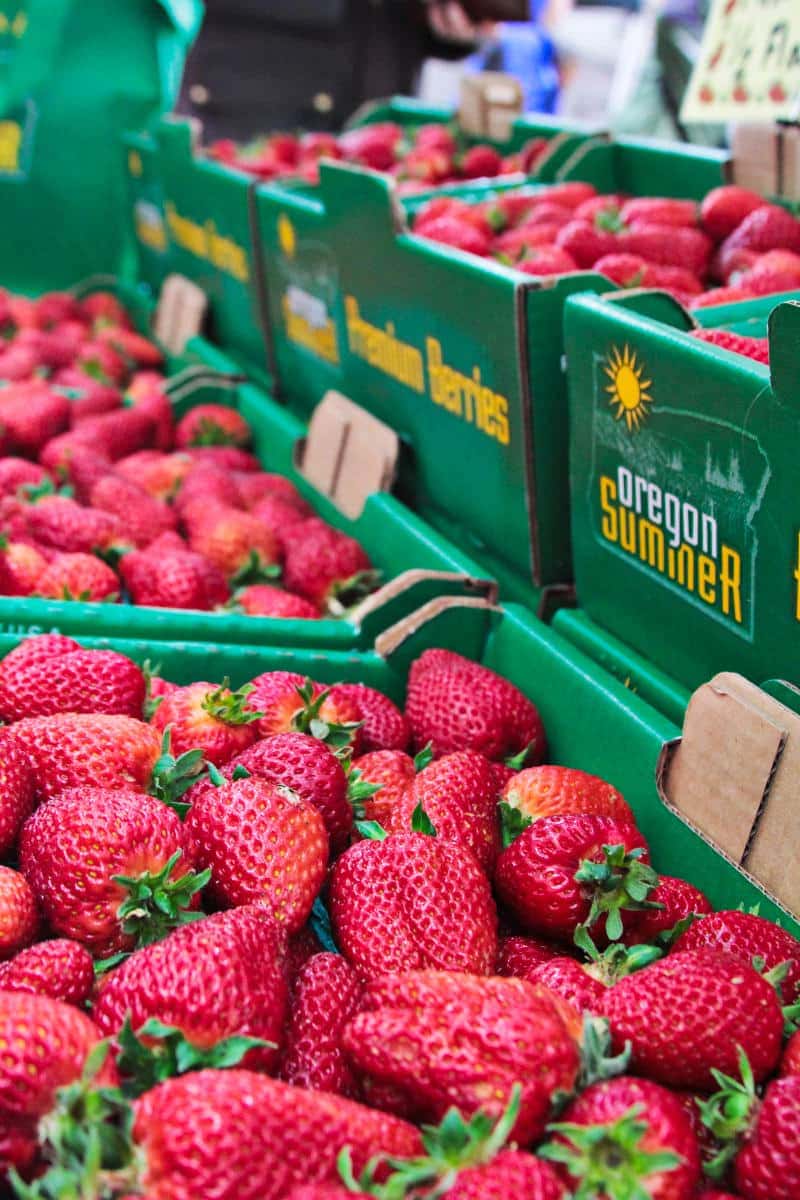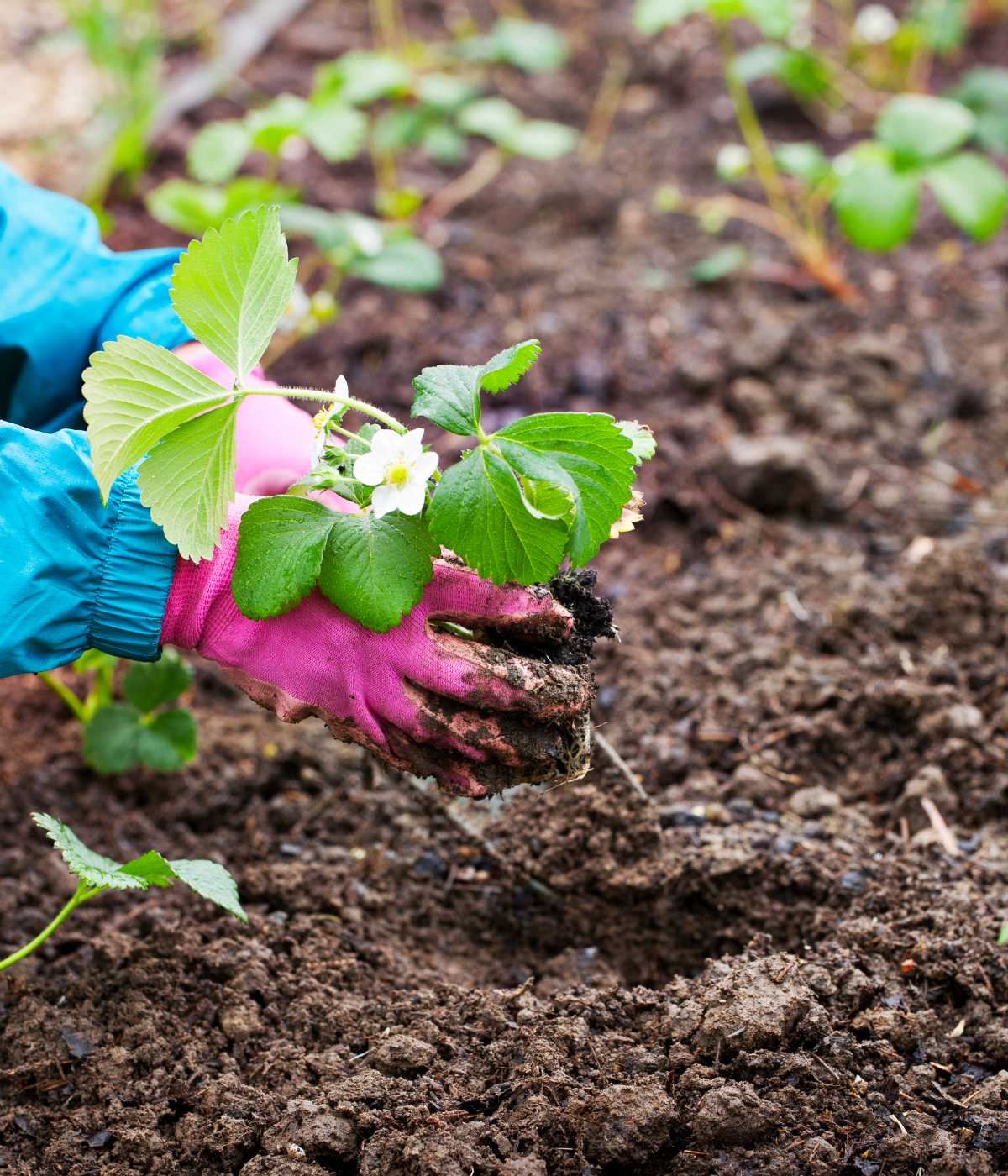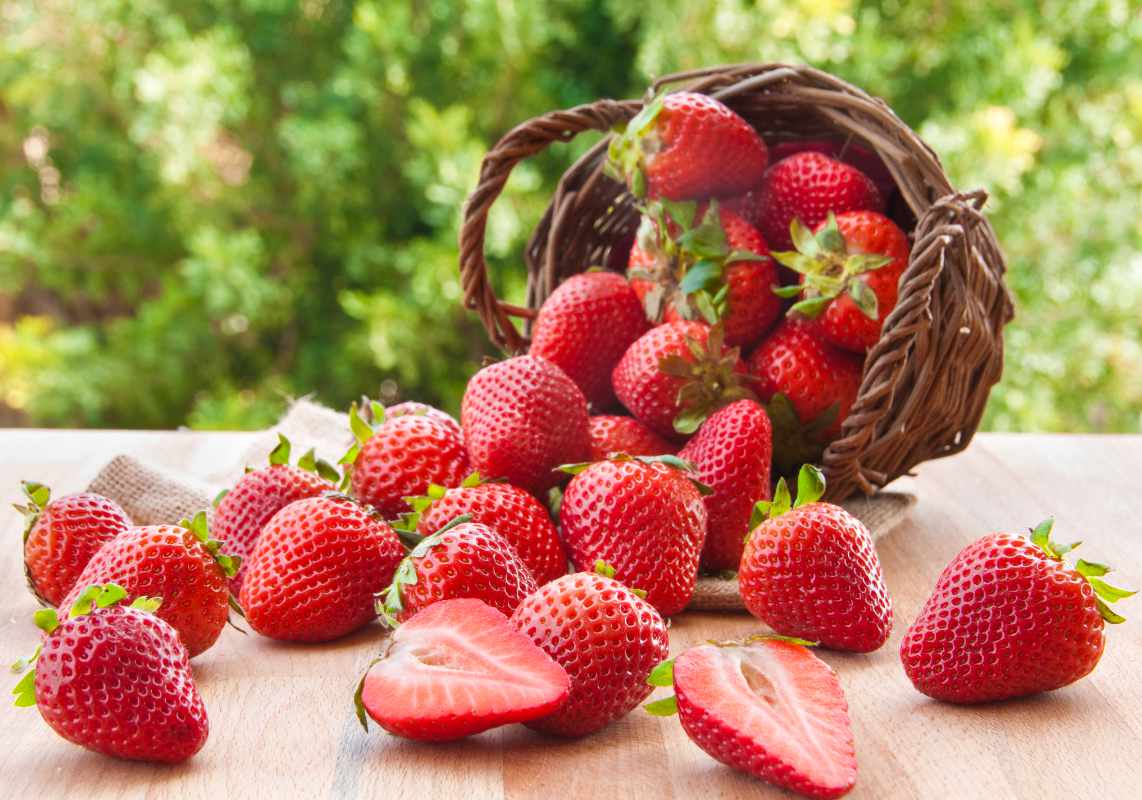Growing sweet strawberries in your home garden can be an enjoyable and rewarding experience.
With a wide variety of strawberry varieties to choose from and the right growing conditions, you can enjoy a bountiful harvest.
This guide will provide expert tips on how to grow strawberries, plant strawberries, care for, propagate, fight disease, and harvest the fruits.

⬇️ Table of Contents
Choosing the Strawberry
When choosing the type of strawberry to plant, consider ever-bearing strawberries, which produce fruit throughout the growing season.
These varieties of strawberries grow well in most climates and are easy to care for.
June-Bearing Strawberries

Ideal for a large, annual harvest. Varieties like Benton, Camarosa, and Chambly yield large, flavorful fruits in late spring or early summer. Best for fresh eating and preserving.
Everbearing Strawberries

Perfect for multiple harvests across seasons. Varieties such as Albion, Hecker, and Ozark Beauty provide strawberries from late spring to early fall. Suited for continuous cropping.
Day-Neutral Strawberries

These plants are not influenced by day length and produce fruit consistently from spring to frost. Varieties like Monterey and Seascape offer smaller, continuous yields. Ideal for steady fruit production.
There are three main types of strawberries: June-Bearing, Everbearing, and Day-Neutral.
Easiest Strawberry Varieties for Beginners
Here are some of the top strawberry varieties recommended for beginners due to their robustness, ease of care, and productive yields.
June-Bearing Varieties: Perfect for Abundant Harvests
- 'Camarosa': This variety is highly prized for its large, very sweet fruits that are perfect for fresh eating and preserving. Camarosa requires standard care and produces abundantly, making it gratifying for first-time growers.
- 'Allstar': Known for producing consistently large, bright red berries, Allstar is resistant to many common strawberry diseases. It is particularly celebrated for its sweet flavor and firm texture, ideal for all types of uses from fresh eating to jams.
Everbearing Varieties: Continuous Harvest
- 'Ozark Beauty': This everbearing variety is well-suited for beginners because it forgives minor neglect and still produces two to three harvests per year. The berries are deliciously sweet and the plants are known for their disease resistance.
- 'Quinault': Quinault is an excellent choice for those with limited space, such as gardeners using containers or small plots. It produces a good yield of soft, tasty berries throughout the growing season.
Day-Neutral Varieties: Flexible Growing Conditions
- 'Albion': Popular for its adaptability and the large, conical berries it produces, Albion is a day-neutral variety that performs well in a wide range of climates. It is known for its disease resistance and consistently high-quality fruit.
- 'Seascape': Seascape strawberries are appreciated for their bold flavor and robust growing nature, which makes them a top pick for beginners. These plants yield fruit from late spring through to the first frost, offering a steady supply of berries.
Planting and Caring for Strawberry Plants
Early spring is a crucial time for strawberry plants as they emerge from dormancy and begin to grow.
Here is essential information on early spring care to day-neutral strawberries to ensure a successful and bountiful harvest:

Plant strawberries in rows, leaving ample space between them for runners to develop. The mother plant will produce runners, which will root and grow into new strawberry plants.

Choosing the Best Location
Strawberries love sunlight, and they do well when planted in a spot that receives at least six hours of direct sunlight per day.
Ensure the area you choose for your strawberries also has well-draining soil to prevent waterlogging, which can lead to root rot and other issues.
Preparing the Strawberry Bed
Space plants about 20 inches apart in rows spaced about four feet apart. When planting, ensure the crown of the plant is slightly above the soil level to prevent rotting.
When to Plant
The best time to plant strawberries is early spring or late fall. This timing allows the plants to establish themselves without the stress of extreme weather.
Soil Preparation
Strawberries thrive in well-draining soil with a pH between 5.5 and 6.8. Enrich your soil with compost and manure to boost fertility before planting.
Strawberry Plant Care
Watering Requirements
Strawberries require about 1 to 2 inches of water weekly, more if the weather is particularly hot or dry. Use a soaker hose or drip irrigation to deliver water directly to the roots, minimizing moisture on the leaves and fruit.
Mulching
Mulching is crucial for strawberry plants. It helps retain soil moisture, control weeds, and protect the roots during extreme temperatures. Pine needles, straw, or shredded leaves make excellent mulch for strawberries.
Fertilizing
Feed your strawberry plants with a balanced fertilizer after planting and again in midsummer to support robust growth and bountiful fruiting.
Pruning and Maintenance
Regular pruning and maintenance of your strawberry plants are essential for a healthy and productive garden.
Remove dead leaves, trim back any damaged growth, and thin out overcrowded areas to ensure proper air circulation and sunlight exposure. This will help keep your plants healthy and encourage better fruit production.
Protecting Plants from Pests and Diseases

Keep an eye out for common pests like slugs and aphids. Natural repellents, such as diatomaceous earth or hand-picking, can effectively manage these pests. Prevent fungal diseases by ensuring your plants have good air circulation and avoiding overhead watering.
Gray Mold (Botrytis cinerea): The first signs are leaves turning brown or yellow; a pale gray fur-like mold will appear over ripe fruits. Maintain proper airflow to prevent infection.
Powdery Mildew: Affects young plant growth and forms white, powdery spots on leaves. Treatment may involve changing location or using appropriate fungicides.
Verticillium Wilt: This disease causes the plant to wilt by discoloring stems and yellowing foliage. It primarily affects strawberries in colder seasons and can be particularly troublesome when the plants are located in areas with a history of disease.
To prevent the spread of Verticillium wilt, swift action is needed by implementing frequent crop rotation and promoting crop diversity. These practices can help mitigate the issue and maintain a healthy strawberry garden.
🎥 Video: How to GROW Strawberries 🍓🌱 Beginners Guide
Propagating Strawberries
To increase your strawberry plants and expand your garden, you can propagate strawberries from the runners produced by the mother plant.

What Are Strawberry Runners?
A strawberry runner is a long, slender stem that extends horizontally from the base of a strawberry plant. It acts as a natural propagation method for strawberries, allowing the mother plant to produce daughter plants.
The runner will eventually develop nodes, or growth points, which, when in contact with the soil, will form roots and establish new strawberry plants. This process is called vegetative propagation.
Propagation: Runners provide an efficient and cost-effective way for gardeners to increase the number of strawberry plants in their garden without purchasing additional plants or relying on seeds.
Rejuvenation: As strawberry plants age, their fruit production declines. By allowing runners to establish new plants, you can ensure a continuous supply of fresh, productive plants to replace older, less productive ones.
Companion Planting for Strawberries
Since strawberries benefit from some specific companion plants, consider planting them alongside plants such as borage, which attracts pollinators and deters pests.
Additionally, marigolds, chives, and onions can help repel pests and prevent diseases due to their strong scents and natural insect-repelling properties.
Vertical Gardening with Strawberries

Greenhouse and High Tunnel Growing

Growing strawberries can be an excellent opportunity to involve children in gardening. Their small size, easy-to-grow nature, and appealing taste make strawberries an ideal choice for introducing kids to the joys of gardening.
Encourage children to participate in planting, watering, and harvesting, and let them enjoy the fruits of their labor as a healthy and delicious snack.
Harvesting and Storing Strawberries

When to Harvest
The best time to pick strawberries is when they are fully red, firm, and fragrant. Early morning is the ideal time for harvesting, as the berries are still cool.
How to Store
After harvesting, keep your strawberries in a cool, dry place. For longer storage, refrigerate them, but avoid washing the berries until you're ready to eat them to prevent spoilage.






Leave a Reply